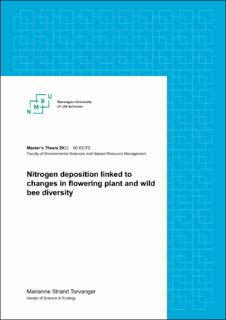| dc.description.abstract | Nitrogen (N) deposition from anthropogenic activities is a major threat to plant biodiversity, but few studies have investigated effects of N deposition on higher trophic levels, such as on flower-visiting insects. N deposition causes nutrient enrichment to ecosystems, resulting in a reduction of legumes (Fabaceae), which is an important insect-pollinated family, particularly for wild bees. In Europe, there has been a decline of long-tongued and specialist bees, and changes in land management – including increased N fertilization – has been identified as a major driver of pollinator decline. However, the impact of atmospheric N deposition on pollinators – including wild bees – is still poorly known.
Here, I used standardized and representative samples of flowering plants and wild bees from 70 sites in Denmark and Norway to assess the effect of N deposition on flowering plant and bee diversity. I explored whether the occurrence of plant and bee species changed in response to increased N deposition, and if the response depended on functional and ecological traits, including plant longevity, bee tongue lengths and floral preferences. I also assessed how bee species occurrences were affected by changes in plant community composition of life-history and soil N preferences with increased N deposition. I hypothesized that plant and bee species responses would be dependent on their ecological and functional traits. In particular, I expected a decline of legumes and their associated pollinators with increasing N deposition.
I found evidence that N deposition had a negative effect on occurrence of perennial plants and legumes. For bees, there was evidence that occurrence of solitary legume specialists decreased with N deposition, both in Norway and the whole region. Bees that increased in occurrence with increased N deposition were generalist species associated with Asteraceae. Contrary to my hypothesis, the probability of legume pollinators occurring increased with N deposition in Norway. However, most of the recorded pollinators of legumes were bumblebees. Thus, bee responses were dependent on functional group and dietary breadth, where generalist bumblebees were not as affected by changes in N deposition and bee species specializing on legumes had the largest decrease in occurrence probability at higher N deposition.
My results indicate that N deposition causes a turnover of plant and bee species, where diversity of legumes and their specialist pollinators will decline in response to increased N deposition. Therefore, ensuring diversity of legumes and corridors for dispersal will be important management practices for the conservation of these species. For example, areas in early successional stages (e.g., roadsides) maintains legume diversity, and can therefore be used to mitigate the impact of N deposition on legume specialist bees. Since N deposition is predicted to increase in the future, my study provides valuable information about species of special conservation interest. | en_US |

